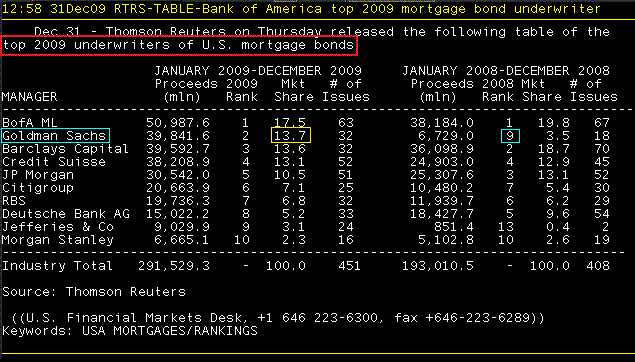Fannie Mae, Ginnie Mae, and Freddie Mac once again kept the mortgage-backed securities (MBS) market going during 2009. The three government-sponsored enterprises wrote 89 percent of all new issues during the year, contributing to an increase of 51 percent in new MBS compared to 2008.
Thomson Reuters reported on the eve of the holiday weekend that $291.5 billion in securities were issued during the year compared to $193.0 billion in 2008. That year was admittedly the slowest year for new MBS this decade, but the 2009 activity was hailed by Thomson Reuters as indication "that investors' appetite for risk improved amid signs of stabilization in the housing market."
The shift to the agency MBS market is not new. It has held the lion's share of the market since 2007 when originators began to shift loan securitization supply away from non-agency sectors as concerns about mortgage foreclosures started to surface.
Bank of America was the leading underwriter of U.S. mortgaged-backed securities, underwriting 63 issues or 17.5 percent of the total market. Bank of America underwritten securities were valued at $51 billion. Goldman Sachs & Co was the second major player with a 13.7 percent market share from underwriting 32 issues totally 39.8 billion, putting them in a near tie with Barclays Capital. The subsidiary of UK lender Barclays underwrote 32 issues worth $39.6 billion, a 13.6 percent market share. The 2009 activity was a major shift for Goldman which underwrote only $6.7 billion in new issues the previous year for a 9th place ranking.

Thomson Reuters also released data for securities issued during the fourth quarter of 2009. Bank of America was also the top underwriter during that period, managing 16 issues worth $10.3 billion, a 15.8 percent market share. Goldman Sachs held second place with 7 issues totaling $8.0 billion, a 12.2 percent share. Credit Suisse was in third place during the quarter with an 11.5 percent share from underwriting 11 issues worth $7.4 billion. Credit Suisse was fourth for the year with 52 issues totaling $38.3 billion, a 10.5 percent share.
Thomson Reuters tracks mortgage bonds backed by whole commercial and residential real estate loans as well as the mortgage-backed securities initially packaged by Fannie Mae, Freddie Mac and Ginnie Mae. Interest-only and principal-only strips of the so-called agencies are not tracked.
MND Managing Editor Adam Quinones provides some insight on applications of the term "underwriter" in the securities market.
Many readers have an understanding of the term underwriter based on its function in the loan application process. In this context, an underwriter is someone (or DU/LP) who reviews the credit and collateral of a borrower before their mortgage application is approved. This version of an "underwriter" looks to ensure the borrower is capable of making timely mortgage payments based on their employment history, savings and investments, and credit history. The underwriter also reviews the collateral, which backs the loan in the event of default, to confirm that the home is re-saleable based on an appraisers opinion.
A mortgage loan underwriter is not the same as an MBS underwriter.
In the context of a mortgage-backed security, the underwriting investment firm (aggregator) essentially purchases unsecuritized loans at a specific price (aggregate coupon yield) with the intention of selling them to an issuer or guarantor (GSEs and Ginnie) for a higher price to lock in yield spread.
An MBS underwriter like Bank of America or Wells Fargo can also be the originator of the MBS issue, meaning they bought loans from smaller loan aggregators (correspondents and brokers) and pooled them together for securitzation by Fannie, Freddie, or Ginnie (label/guarantee) which will then be resold in the secondary market or held in the GSE portfolio.
Plain and Simple: MBS "underwriters" are at the top of the supply chain when it comes to aggregating unsecuritized mortgage loans.
(This varies from a CMO underwriter who aggregate already securitized pools and looks to resell for higher price. Key difference: loans are already securitized and trading in the secondary market.)







